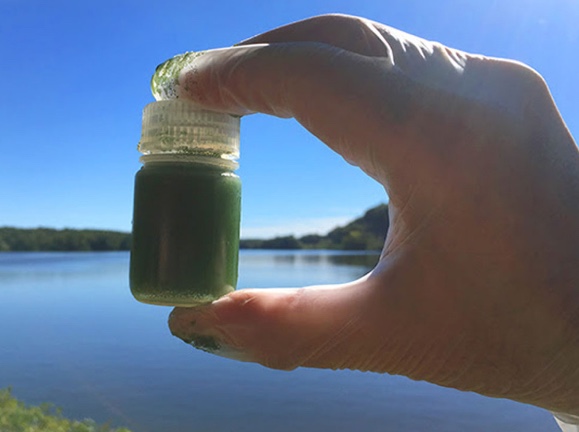
On March 28th of this year, nearly a hundred people gathered at SUNY New Paltz for the third Wallkill River Summit, organized by the Wallkill River Watershed Alliance.
Gathering together community organizers, officials from the NYS Department of Environmental Conservation, local elected leaders and an interested public, the 2017 Wallkill River Summit showcased three areas of emerging science in the watershed:
- New data on nutrient pollution
- An update on ongoing testing for fecal contamination
- Algae and Harmful Algal Blooms
And five updates on important projects in the watershed:
- The development of a plan for the Monhagen Brook,
- Flood control measures being installed in the Black Dirt region,
- Recent news on the Pilgrim Pipeline, slated to be run underneath the Wallkill at Rifton,
- An upcoming project to plan for climate change in the watershed,
- A survey of the state of the river’s fishery, and
- Removal of badly designed dams and culverts.
But of all the information presented, the most cutting edge work was delivered by two scientists, Dr. Neil Bettez and Jennifer Epstein (of Riverkeeper), both from the Alliance’s Science Working Group.
Fecal Contamination is a Major Problem in the Wallkill

Fecal contamination is a major problem in the Wallkill River. For five years (and continuing this year in its sixth), Riverkeeper has been partnering with community scientists throughout the watershed to test the waters for Enterococcus, a pathogen only found in the intestines of warm-blooded animals, including humans. What they’ve discovered is that in almost every stretch of the river, the fecal contamination makes it unsafe to swim almost all of the time. The caveats are important; there ARE times and places it would be safe to swim, but so few and so rarely that you’d have to test the water each time you tried.
Among major tributaries of the Hudson River, only the Sparkill is more contaminated by sewage than the Wallkill. In fact on average, the Wallkill has Enterococcus counts far higher than the EPA recommends — nearly always ten times the recommended levels at all twenty four sampling sites.
Nutrients Poison the River as Well
Fecal contamination is just one of the many problems plaguing the Wallkill. It is, for instance, just one source of nutrients leaching into the river. Too many nutrients running off into rivers and streams can overwhelm aquatic ecosystems, leading to algae blooms and their rarer cousins, the Harmful Algae Blooms.
Nutrients reach the river from a variety of sources, but mainly fertilizer and manure running off farms, urban street water washing nutrients from our villages and hamlets, and leaking sewer and septic systems.
So we know there are inputs of nutrients in the Wallkill watershed, simply by virtue of the farms and villages that drain to the river. What we didn’t know was how much nutrient pollution we were dealing with, or where it was coming from.

Last year, thanks to a Hudson River Estuary Program grant secured by Riverkeeper, the Alliance’s Science Working Group put in place a testing regime for nutrient pollution. Every month at 24 locations, and every Monday in August, samples were taken at the mouths of all the major subwatersheds and sent to Cary Institute’s Analytical Laboratory in Millbrook, NY to measure concentrations of nitrogen (ammonium nitrate) and phosphorus (phosphate). Over the course of the sampling period, there were different hydrological conditions, ranging from drought to storm surges.
The results of our sampling arrived shortly before the Summit. Dr. Neil Bettez presented the results, which are still being interpreted. All of the tributaries tested had nutrient levels much higher the EPA recommends, but several tributaries stand out. Quaker Creek and the Rio Grande — both in the Town of Goshen, NY — had nutrient levels orders of magnitude higher than recommended, and much high than any of the other tributaries sampled.
Something is going on in those watersheds, and one of the next steps for the Alliance (along with our allies) is to figure out exactly what it is. It still remains to be seen if the nutrient loads from those creeks, however, are associated with the Harmful Algal Blooms observed far downstream. There are ecological questions still to be answered.
The People Step Forward

After we spoke about nutrients and pathogens, planning and fishing, culverts, flooding and oil pipelines, we closed the night with a panel of Alliance leaders, each of our Working Group Chairs discussed ways to get involved. The standard opportunities were of course presented — come to a meeting, call your representatives, make a donation. But we also called for citizen scientists, for volunteer samplers, and for recruits for “stream teams” to explore the river’s tributaries, among other projects. We urged attendees to join our call, jointly with Riverkeeper, to have the state fund an enhanced monitoring study of the Wallkill that will – we hope – help to answer some key questions about the sources and impacts of some pollutants in the river. Municipalities, including Goshen, New Paltz and Gardiner; Ulster County; and several state representatives also joined the call, a significant milestone in the work of the Alliance to build community support for the river’s restoration.
The calls for volunteers seemed to have worked. In the weeks since the Wallkill River Summit, the Alliance has grown, with new members stepping forward in response to calls to action on our email lists and social media. While still small – at least in relation to the size of the watershed, which covers two states, three counties and over 40 municipalities –the Wallkill River Watershed Alliance is growing, which is heartening. It’s a big river, with a long road ahead towards its restoration.

